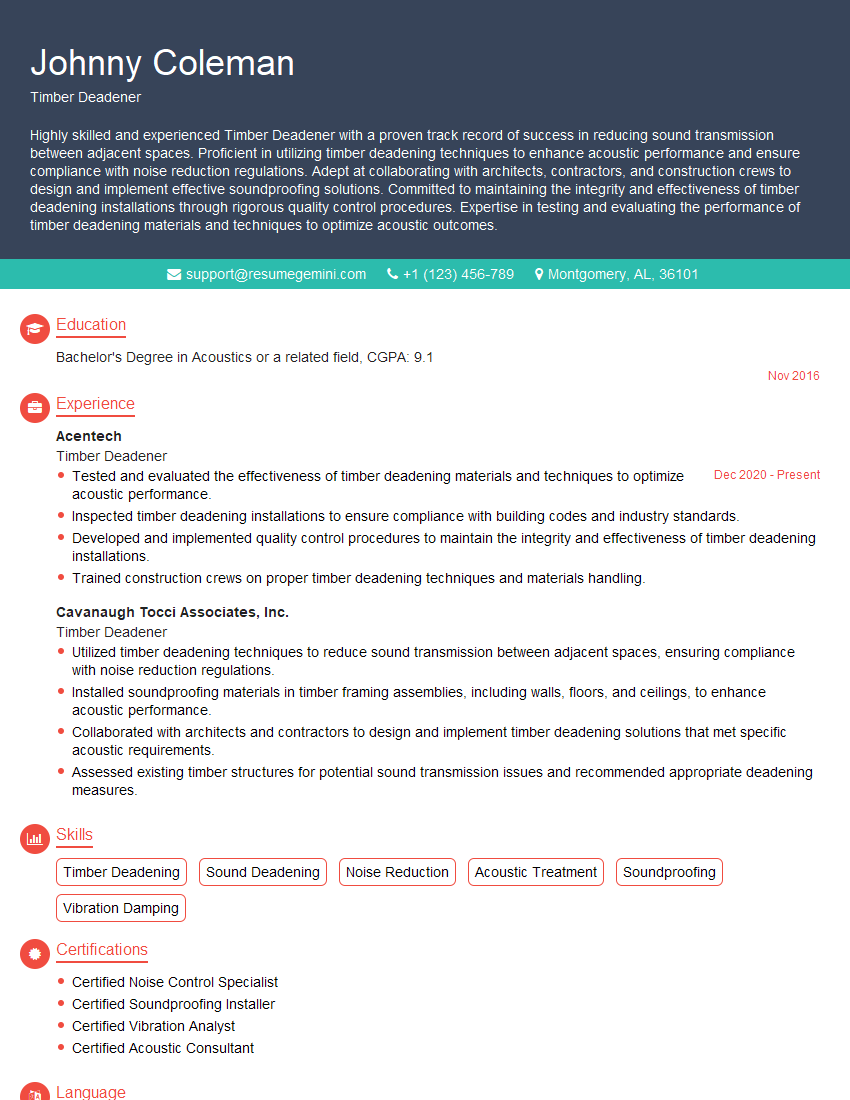Are you a seasoned Timber Deadener seeking a new career path? Discover our professionally built Timber Deadener Resume Template. This time-saving tool provides a solid foundation for your job search. Simply click “Edit Resume” to customize it with your unique experiences and achievements. Customize fonts and colors to match your personal style and increase your chances of landing your dream job. Explore more Resume Templates for additional options.

Johnny Coleman
Timber Deadener
Summary
Highly skilled and experienced Timber Deadener with a proven track record of success in reducing sound transmission between adjacent spaces. Proficient in utilizing timber deadening techniques to enhance acoustic performance and ensure compliance with noise reduction regulations. Adept at collaborating with architects, contractors, and construction crews to design and implement effective soundproofing solutions. Committed to maintaining the integrity and effectiveness of timber deadening installations through rigorous quality control procedures. Expertise in testing and evaluating the performance of timber deadening materials and techniques to optimize acoustic outcomes.
Education
Bachelor’s Degree in Acoustics or a related field
November 2016
Skills
- Timber Deadening
- Sound Deadening
- Noise Reduction
- Acoustic Treatment
- Soundproofing
- Vibration Damping
Work Experience
Timber Deadener
- Tested and evaluated the effectiveness of timber deadening materials and techniques to optimize acoustic performance.
- Inspected timber deadening installations to ensure compliance with building codes and industry standards.
- Developed and implemented quality control procedures to maintain the integrity and effectiveness of timber deadening installations.
- Trained construction crews on proper timber deadening techniques and materials handling.
Timber Deadener
- Utilized timber deadening techniques to reduce sound transmission between adjacent spaces, ensuring compliance with noise reduction regulations.
- Installed soundproofing materials in timber framing assemblies, including walls, floors, and ceilings, to enhance acoustic performance.
- Collaborated with architects and contractors to design and implement timber deadening solutions that met specific acoustic requirements.
- Assessed existing timber structures for potential sound transmission issues and recommended appropriate deadening measures.
Certificates
- Certified Noise Control Specialist
- Certified Soundproofing Installer
- Certified Vibration Analyst
- Certified Acoustic Consultant
Languages
- English
- French
- German
Career Expert Tips:
- Select the ideal resume template to showcase your professional experience effectively.
- Master the art of resume writing to highlight your unique qualifications and achievements.
- Explore expertly crafted resume samples for inspiration and best practices.
- Build your best resume for free this new year with ResumeGemini. Enjoy exclusive discounts on ATS optimized resume templates.
How To Write Resume For Timber Deadener
- Highlight your expertise in timber deadening techniques and soundproofing materials.
- Quantify your accomplishments whenever possible, using specific metrics to demonstrate your impact.
- Showcase your ability to collaborate effectively with architects, contractors, and construction crews.
- Emphasize your commitment to quality by describing your role in developing and implementing quality control procedures.
- Include keywords throughout your resume that are relevant to the timber deadening industry, such as ‘soundproofing,’ ‘noise reduction,’ and ‘acoustic treatment.’
Essential Experience Highlights for a Strong Timber Deadener Resume
- Utilized timber deadening techniques to reduce sound transmission between adjacent spaces, ensuring compliance with noise reduction regulations.
- Installed soundproofing materials in timber framing assemblies, including walls, floors, and ceilings, to enhance acoustic performance.
- Collaborated with architects and contractors to design and implement timber deadening solutions that met specific acoustic requirements.
- Assessed existing timber structures for potential sound transmission issues and recommended appropriate deadening measures.
- Tested and evaluated the effectiveness of timber deadening materials and techniques to optimize acoustic performance.
- Inspected timber deadening installations to ensure compliance with building codes and industry standards.
- Developed and implemented quality control procedures to maintain the integrity and effectiveness of timber deadening installations.
- Trained construction crews on proper timber deadening techniques and materials handling.
Frequently Asked Questions (FAQ’s) For Timber Deadener
What is the role of a Timber Deadener?
A Timber Deadener is responsible for reducing sound transmission between adjacent spaces by utilizing timber deadening techniques and installing soundproofing materials in timber framing assemblies.
What are the key skills required for a Timber Deadener?
Key skills include proficiency in timber deadening techniques, soundproofing materials, and acoustic treatment principles, as well as the ability to collaborate with architects, contractors, and construction crews.
What industries employ Timber Deadeners?
Timber Deadeners are employed in various industries, including construction, architecture, and acoustics consulting.
What are the career prospects for Timber Deadeners?
Timber Deadeners with strong technical skills and experience can advance to roles such as Acoustic Consultant or Project Manager.
What is the earning potential for Timber Deadeners?
The earning potential for Timber Deadeners varies depending on experience, skills, and location, but it is generally competitive within the construction industry.
What are the challenges faced by Timber Deadeners?
Timber Deadeners may face challenges related to staying up-to-date with the latest techniques and materials, as well as working in noisy and potentially hazardous environments.
What is the job outlook for Timber Deadeners?
The job outlook for Timber Deadeners is expected to remain stable or grow slightly in the coming years, driven by increasing demand for noise reduction in buildings and other structures.